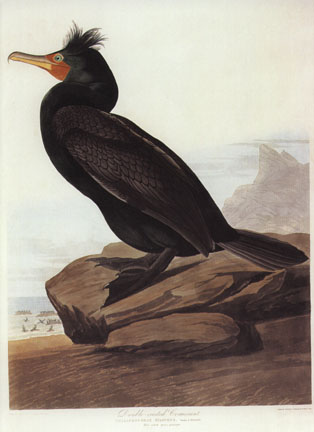| Double-crested Cormorant
I saw my first Robin yesterday. A flash of red belly as it flew away. Spring is getting closer.
The winter birds are still here though. The Buffleheads are still out on the lake diving for food. Another winter bird out on the lake diving for food has been the Double-crested Cormorant. I have seen four at one time. I haven't seen any for a week or so until this afternoon.

Double-crested Cormorant Phalacrocorax auritus
The Double-crested Cormorant forms its nest of sea-weeds, some sticks, moss, and clods of earth, with grass adhering to them, which it piles up into a solid mass, often as high as three feet from the rock, with a diameter of fifteen or eighteen inches at the top, and of two and a half feet at the base. The whole has an appearance of solidity seldom seen in the nests of water-birds. The nests are placed as near each other as the nature of the ground will permit, and a great number which appeared to have stood out against the winter storms, had been enlarged and repaired that season. Many, however, lay scattered over the rocks, having been demolished by heavy gales or the breaking of the surf during tempests. The whole surface of the rock resembled a mass of putridity: feathers, broken and rotten eggs, and dead young, lay scattered over it; and I leave you to guess how such a place must smell in a calm warm day. The eggs are three or four, average two and a half inches in length by one inch and four and a half eighths in breadth, and have an elongated form. They are covered with a calcareous coating, which is more or less soiled with filth, but when carefully scraped, shews a fine light greenish-blue tint.
[read more]
Pictures and text by John James Audubon.
These are good sized birds. Cormorants aren't very popular with fisherman though. A number of links that I found were very disparaging of these birds. It seems they eat the same fish the fisherman want to catch. Honeymoon Lake is stocked with trout and those trout have been providing a nice winter feast for the Cormorants. After they have finished diving for fish, they will climb up on a dock and spread their wings to dry them.
They flap their wings and start running on the water to take off. It takes a bit to get them airborne. They will then fly in a couple of large circles gaining altitude until they finally fly toward the salt water and out of site.
Double-crested Cormorant Phalacrocorax auritus
Double-crested Cormorant Phalacrocorax auritus
Double-crested comorant Phalacrocorax auritus
Double-Crested Comorant - (Phalacrocorax auritus)
One of those sites that seem to find the Cormorant as a less than desirable neighbor:
Southern California's Cormorant Problem
Fellow anglers, the cormorant (ugly black bird found in ALL So. Cal. trout lakes) is eating up all of our trout! Each year, we anglers pay big $$ in fishing license fees so our lakes are regularly stocked with trout for us to catch. Based on my own witness and stories told by other anglers, I believe this bird is responsible for more than 50% of the DFG trout taken fom our waters.
 |

